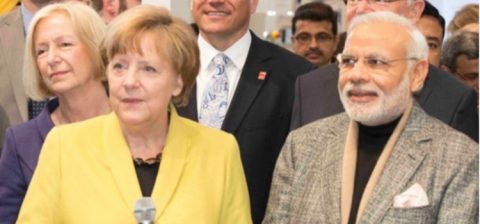
India en Duitsland: alliantie tegen klimaatverandering
6 oktober 2015 – India en Duitsland gingen maandag een alliantie aan in de strijd tegen klimaatverandering. De ‘Indo-German Climate and Renewable Alliance’ richt zich vooral op de ontwikkeling van duurzame energie en energiebesparing.
De Duitse bondskanselier Angela Merkel is deze week op bezoek in India. Tijdens haar bezoek begonnen de landen, in aanloop naar de klimaattop in Parijs, een ‘Indo-German Climate and Renewable Alliance’.
Uit een bericht van de Times of India
‘(…) The alliance will be a comprehensive partnership to harness “technology, innovation and finance” in order to make affordable, clean and renewable energy accessible to all and to foster climate change mitigation efforts in both countries. (…)’
De landen gaan zich richten op zeven gebieden. DNA India zette ze op een rij:
– Next generation solar technology
– Renewable energy storage
– Climate-friendly space cooling technologies
– Super-efficient appliances and buildings
– Zero emission passenger and freight vehicles
– Energy-efficient rail and water infrastructure
– Offshore wind
Opvallend is dat beide landen onderstreepten dat ‘adaptatie’ een belangrijk onderdeel zou moeten zijn van een klimaatakkoord in Parijs, aldus de Times of India. Dat punt wordt vaker gemaakt door India, maar de meeste rijkere landen willen een akkoord waarbij het voorkomen van klimaatverandering centraal staat.
Berlijn steekt 1 miljard euro in zonneprojecten India
India en Duitsland tekenden tijdens het bezoek van Merkel 18 MoUs (Memorandum of Understanding, principe-afspraken), over uiteenlopende onderwerpen als veiligheid, spoorwegen en onderwijs, ter waarde van 2 miljard euro. Een daarvan is de toezegging van Duitsland om 1 miljard euro te investeren in zonneprojecten in India. Dat komt bovenop de 1,15 miljard euro die Berlijn al had beloofd voor de ‘Green Energy Corridors Partnership’, een initiatief van India om netwerken aan te leggen om energie te vervoeren van plekken waar veel hernieuwbare energie opgewekt kan worden naar plekken waar dat niet kan. De afspraken sluiten aan bij de klimaatplannen die India op de valreep indiende bij de Verenigde Naties.
Uit een bericht van Germanwatch
‘(…) “Der Solarplan unterstützt den dringend benötigten Ausbau der Erneuerbaren Energien in Indien”, erklärt Rixa Schwarz, Indien-Expertin bei Germanwatch. “Mit diesem Ausbau kann Indien die Ankündigung von letzter Woche, 40 Prozent der Stromkapazität bis 2030 aus nicht-fossilen Energiequellen zu decken, durch Erneuerbare Energien und nicht durch Atomkraft erreichen.” (…)’
Klimaatplan India
India, ’s werelds twee-na-grootste CO2-uitstoter, beloofde in zijn Intended Nationally Determined Contribution (INDC) in 2030 33 tot 35 procent minder broeikasgassen uit te stoten dan in 2005. Een extra In 2030 wil India 40 procent van de elektriciteit duurzaam opwekken.
Een reactie van klimaatchef Christiana Figueres in the Guardian
‘(…) Christiana Figueres said India’s pledge was vital. “It is one of the very large developing countries and it will be very important to see what their trajectory on energy is going to be and, in particular, how they are planning to provide energy to 400 million un-electrified people in india.” (…)’
Premier Modi van India was de weg naar duurzame energie al ingeslagen, met het doel om in 2022 175 GW aan hernieuwbare energie op te kunnen wekken en om door het hele land 20 miljoen straatlampen te voorzien van led, aldus enie.net. Maar India bepaalt graag zelf het tempo.
Uit een bericht van the Guardian
‘(…) Modi has repeatedly said India would not accept constraints on its development as part of any climate deal. Unlike China’s submission to the UN in June, India’s does not spell out when its emissions might peak. (…)’
De beloftes van India uit de ingezonden INDC
‘(…)
- To put forward and further propagate a healthy and sustainable way of living based on traditions and values of conservation and moderation.
- To adopt a climate friendly and a cleaner path than the one followed hitherto by others at corresponding level of economic development.
- To reduce the emissions intensity of its GDP by 33 to 35 percent by 2030 from 2005 level.
- To achieve about 40 percent cumulative electric power installed capacity from non- fossil fuel based energy resources by 2030 with the help of transfer of technology and low cost international finance including from Green Climate Fund (GCF).
- To create an additional carbon sink of 2.5 to 3 billion tonnes of CO2 equivalent through additional forest and tree cover by 2030.
- To better adapt to climate change by enhancing investments in development programmes in sectors vulnerable to climate change, particularly agriculture, water resources, Himalayan region, coastal regions, health and disaster management.
- To mobilize domestic and new & additional funds from developed countries to implement the above mitigation and adaptation actions in view of the resource required and the resource gap.
- To build capacities, create domestic framework and international architecture for quick diffusion of cutting edge climate technology in India and for joint collaborative R&D for such future technologies. (…)’
Bronnen
Times of India, 6 oktober 2015: Ahead of Paris meet, Berlin’s billions put India firmly on low-carbon track
Times of India, 6 oktober 2015: Merkel pledges 1 billion euros for solar energy
Times of India, 5 oktober 2015: India and Germany sign 18 MoUs
The Guardian, 2 oktober 2015: India unveils climate change plan
The Guardian, 3 juli 2015: India’s climate pledge ‘critically important’, says UN climate chief
edie.net, 2 oktober 2015: India pledges to cut carbon intensity by 35%
Germanwatch, persbericht, 6 oktober 2015: Neue Indisch-Deutsche Allianz für Klima und Erneuerbare Energien kann nachhaltige Entwicklung vorantreiben
DNA India, 5 oktober 2015: India, Germany sign Indo-German Climate and Renewables Alliance
India’s Intended Nationally Determined Contribution: Working Towards Climate Justice
Foto: Europese Commissie



